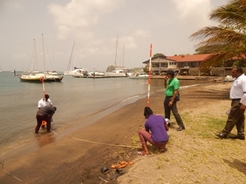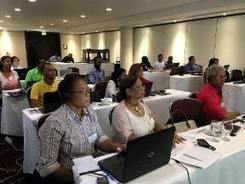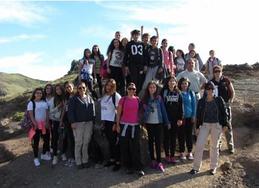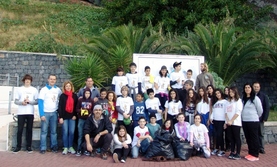Sandwatch Activities (2015)

Creating a beach profile with Sandwatchers in St. Vincent and the Grenadines
My name is Sternley Walker from the beautiful Island of St. Vincent and the Grenadines. I am very excited to share my experience in a beach profile training I attended from August 19-21, 2015. The group was energetic for the process and the facilitator’s method of teaching was very easy to follow.I was particularly happy to know this training was facilitated by one of our very own, a local Vincentian whose name is Mr. Herman Belmar, and hid Sandwatch his team who reside in Bequia, one of the exquisite Grenadines Islands of St. Vincent. Usually, most training of such are conducted by persons from the regional or international community. - Please click here to see our report and photos!
My name is Sternley Walker from the beautiful Island of St. Vincent and the Grenadines. I am very excited to share my experience in a beach profile training I attended from August 19-21, 2015. The group was energetic for the process and the facilitator’s method of teaching was very easy to follow.I was particularly happy to know this training was facilitated by one of our very own, a local Vincentian whose name is Mr. Herman Belmar, and hid Sandwatch his team who reside in Bequia, one of the exquisite Grenadines Islands of St. Vincent. Usually, most training of such are conducted by persons from the regional or international community. - Please click here to see our report and photos!

The Sandwatch Online Database Project in the Dominican Republic: Part 2
Proyecto del Mar Caribe “Observando la Arena” On 19th of November, 2015 a Sandwatch Online Database workshop was held in the Dominican Republic as a follow up to the earlier May 18th-22nd meeting. Dr. David Grey of the Sandwatch Foundation and creator of the database travelled from Halifax, Nova Scotia to facilitate the workshop. Ms. Khalissa Ikhlef Program Specialist, Local and Indigenous Knowledge Systems at UNESCO HQ, (Paris, France) also assisted with the training. Photos by Miguel Coradin for Observando la Arena CSJO - Please click here to see our full report and photos!
Proyecto del Mar Caribe “Observando la Arena” On 19th of November, 2015 a Sandwatch Online Database workshop was held in the Dominican Republic as a follow up to the earlier May 18th-22nd meeting. Dr. David Grey of the Sandwatch Foundation and creator of the database travelled from Halifax, Nova Scotia to facilitate the workshop. Ms. Khalissa Ikhlef Program Specialist, Local and Indigenous Knowledge Systems at UNESCO HQ, (Paris, France) also assisted with the training. Photos by Miguel Coradin for Observando la Arena CSJO - Please click here to see our full report and photos!

Building Climate Change Resilience in the Natural Reserve of Ponta de São Lourenço
During the last years, within the framework of the Sandwatch project, our school, the Escola Básica do 2º e 3º Ciclos do Caniço has been involved in an educational process through which students, teachers and our local community are working together monitoring our coastal environment and developing sustainable approaches to address the problems found. Throughout the process, a fundamental aspect enabling our actions has been the profuse collaboration between partners that goes far beyond our school walls. Once again, our school has participated in an action promoted by the project LIFE Eco Compatível led by the Natural Park of Madeira, in collaboration with the Four Views Hotels (and their partners Quinta do Lorde Resort and Mbtravel) which took place at “Ponta de São Lourenço”. - Please click here to see our full report and photos!
During the last years, within the framework of the Sandwatch project, our school, the Escola Básica do 2º e 3º Ciclos do Caniço has been involved in an educational process through which students, teachers and our local community are working together monitoring our coastal environment and developing sustainable approaches to address the problems found. Throughout the process, a fundamental aspect enabling our actions has been the profuse collaboration between partners that goes far beyond our school walls. Once again, our school has participated in an action promoted by the project LIFE Eco Compatível led by the Natural Park of Madeira, in collaboration with the Four Views Hotels (and their partners Quinta do Lorde Resort and Mbtravel) which took place at “Ponta de São Lourenço”. - Please click here to see our full report and photos!

Madeira: Cleaning the "Levadas" and ensuring good quality coastal waters
Madeira is an island of just 756 square kilometers, however, has a complex irrigation system consisting of a meandering channel network with over 1500 km. These channels are the “Levadas” which cross the steep topography of the island and are the result of an epic work that has been shaping the landscape for over five centuries. The “Levadas” are an important part of the cultural heritage of the island of Madeira. The first ones were soon built at the beginning of colonization in the fifteenth century, in order to irrigate the land. The North side of the island is rich in vigorous springs but is on the South side that are the most fertile but dry land. The cultivation of cereals, sugar, vines and banana was only possible thanks to these water paths that through steep cliffs and the Forest of Laurissilva, carry the water from where it springs up to where is needed.
- Please click here to go to our homepage
-Please click here to d/l our full report and photos (800kb pdf format)
Madeira is an island of just 756 square kilometers, however, has a complex irrigation system consisting of a meandering channel network with over 1500 km. These channels are the “Levadas” which cross the steep topography of the island and are the result of an epic work that has been shaping the landscape for over five centuries. The “Levadas” are an important part of the cultural heritage of the island of Madeira. The first ones were soon built at the beginning of colonization in the fifteenth century, in order to irrigate the land. The North side of the island is rich in vigorous springs but is on the South side that are the most fertile but dry land. The cultivation of cereals, sugar, vines and banana was only possible thanks to these water paths that through steep cliffs and the Forest of Laurissilva, carry the water from where it springs up to where is needed.
- Please click here to go to our homepage
-Please click here to d/l our full report and photos (800kb pdf format)

Sandwatch takes part in Scientific Conference on “Our Common Future under Climate Change” July 7- 10 2015, Paris, France
This large international science conference, held before the Paris COP21, took place in Paris, France with close to 2,000 participants from almost 100 countries. Together they explored current understanding of all dimensions of the climate change challenge plus the full range of mitigation and adaptation options that can lead to sustainable, equitable solutions across all nations and regions. The main objective of COP21 in December 2015 is to produce a cooperation framework among governments for addressing the challenge of climate change. During one of the parallel sessions on “Climate Change Education for Sustainable Development – Towards holistic science education” Gillian Cambers, Co-Director of the Sandwatch Foundation, gave a presentation on “Towards holistic Sandwatch Education through Sandwatch”. The presentation can be downloaded here.
This large international science conference, held before the Paris COP21, took place in Paris, France with close to 2,000 participants from almost 100 countries. Together they explored current understanding of all dimensions of the climate change challenge plus the full range of mitigation and adaptation options that can lead to sustainable, equitable solutions across all nations and regions. The main objective of COP21 in December 2015 is to produce a cooperation framework among governments for addressing the challenge of climate change. During one of the parallel sessions on “Climate Change Education for Sustainable Development – Towards holistic science education” Gillian Cambers, Co-Director of the Sandwatch Foundation, gave a presentation on “Towards holistic Sandwatch Education through Sandwatch”. The presentation can be downloaded here.